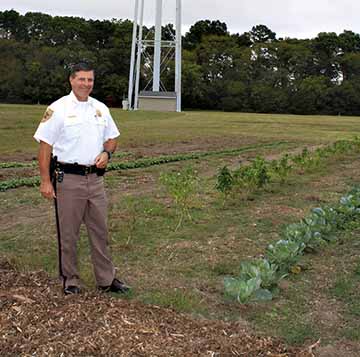Story by Stefanie Jackson – Photo by Angie H. Crutchley – Participants in the Eastern Shore Regional Jail’s new re-entry program are growing into productive citizens, but that’s not all they’re growing.
The participants attend classes every day, but they also get to go outside, breathe fresh air, and get their hands dirty working in the jail’s new garden, growing fresh, organic vegetables that everyone at the facility can eat.
The garden was the idea of Dep. Clark Lovelady, the re-entry program facilitator.
The program’s director is the Rev. Kelvin Jones, the chaplain at ESRJ. Capt. Roger Kennedy and Lt. Francis Williams are also involved.
ESRJ staff realized “three hots and a cot” wasn’t working for the inmates, Jones said.
They decided it was time to change the culture at the jail, focusing less on punishment and more on rehabilitation.
The staff wanted to establish a re-entry program modeled after those used throughout the commonwealth. Virginia’s current rate of recidivism (re-offending) is 23.4%, the lowest in the nation for three years.
Gov. Ralph Northam appointed Jones to work in the Virginia Department of Corrections, where Jones served as a re-entry specialist for about 10 months.
Not every county jail has a re-entry program, but because of an agreement between Accomack and Northampton counties, inmates at Accomack County Jail may also apply for the voluntary program.
Graduates get a GED, DMV ID card, a $5,000 federal bond to guard against theft for a future employer, a certificate of incarceration, and certificates of completion for all classes taken.
There is also a ready-to-work class for any student who already has a GED or diploma.
Other classes include T4C (Thinking for a Change), classes on anger management and substance abuse, and InsideOut Dad. (And since the re-entry program includes two cohorts – eight women in addition to eight men – a class for moms will be added soon, too.)
Then there’s the garden. The inspiration for the garden originated with Lovelady’s former employer in Richmond, who donated gardens to local elementary schools. The company employees wrote lesson plans incorporating the Standards of Learning (SOLs) and taught gardening to the students for an hour every week.
Going outside to work in the garden was like “recess, but with learning” for the kids, Lovelady said. He noticed how much calmer the students became after gardening. Their behavior and grades began to improve.
Re-entry program participant Carla Nicole Koester, of Baltimore, Md., agreed that “putting your hands in the dirt” is a form of “therapy.”
The re-entry program has been “the biggest blessing” for Koester, who has five months left on her 17-month sentence for breaking and entering and grand larceny.
Jones “fine tuned” the program for the women’s cohort, placing emphasis on trauma-informed care, since female inmates typically experience more trauma than males do prior to incarceration. It’s an aspect of the re-entry program Koester appreciates.
“I deserve a better life,” she said – something she realized only through her participation in the program.
The 47-year-old mother of two grown sons will seek that better life back in Baltimore when she’s released.
Koester’s garden favorites are spinach and butter beans, and she looks forward to the bok choy.
Re-entry program participant George Walker, of Exmore, remembers the tomato as the first garden vegetable he ever tried. He’s also learned to like turnips.
He likes the re-entry program and the garden because “they gave us a chance, instead of sitting in a block all day,” to actually do something to try to change.
Walker, who has two years left of a three-year sentence for malicious wounding, finds the social aspect of cooperating with others in the garden especially helpful.
“If you’re not willing to help each other, you can’t help yourself,” he said.
Walker, who is only 28 years old, also wants to learn how to be a better father to his 10 kids – nine children and one stepchild.
The average participant enters the program when he has about six months left on his sentence, but because Walker still has two years to go, he’ll be able to repeat the program later as an “elder” and help out new participants.
The groundbreaking for the garden was April 11, about six months ago. The first participants of the re-entry program will graduate Dec. 11.
Lovelady said for every graduating class, a bush or fruit-bearing tree will be planted.
The cost of the re-entry program is not included in ESRJ’s budget; it is funded through outside sources. Many of the items used in the garden are donated by local businesses or are constructed from reclaimed materials. A portion of the crops are allowed to go to seed so new plants don’t have to be bought every season. The garden is 100% organic. No herbicides or pesticides are used and participants often remove pests by hand.
The program appears to be successfully preparing its participants to re-enter society.
Walker said when he and his classmates began the program, they were “strangers,” but now they are “brothers.”



